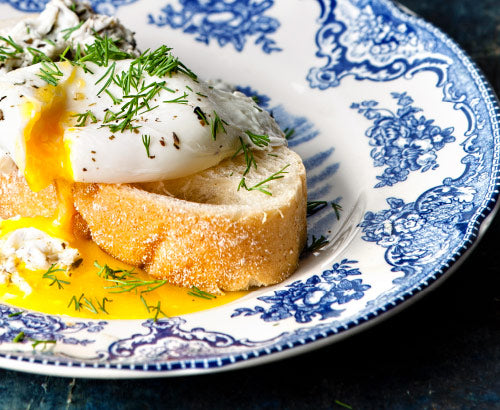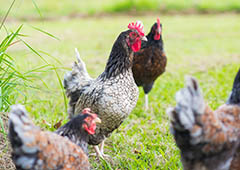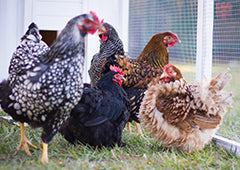Plumage got you in a pickle? Confused by coccidiosis? What on earth is a pullet?! If chicken chat is sending you into a tizzy, be sure to keep our ‘Chicktionary’ handy. The ultimate guide to chicken terminology, the ‘Chicktionary’ will make sure you aren’t left scratching your head when mingling with those chicken inclined folk among us.

A
Addled Egg: Fertile egg in which the embryo has died after initially starting to grow. It can also refer to an egg that has begun to go bad.
Air Cell/pocket/sac/space: Occurs between the inner and outer shell membranes of the egg, and provides a chick with air before it breaks free from the shell.
Albumen: Also known as the ‘white’, and is formed from four thick and thin layers. Contains approximately 40 different proteins in addition to water, and surrounds and protects the egg yolk.
Autosexing: The term for breeds in which the chick’s sex can be distinguished soon after hatching by it’s colouring.
Axial Feather: Short wing feather that lies between the primary and secondary feathers on a chicken’s wing
B
Bantam: A miniature fowl, about one-fourth to one-half the size of a regular sized chicken. Some breeds are True Bantams, which are naturally occuring and have no large fowl equivalent.
Banty: Affectionate term for Bantam.
Barring: Pattern of alternating dark and light stripes running across the feather. Chickens with this patterning will be known as ‘Barred’ e.g. Barred Plymouth Rock.
Bay: A reddish-brown plumage colour.
Beard: The feathers found around the throat of some chicken breeds.
Biddy: Affectionate word for a hen. (More specifically a laying hen more than one year old).
Blastodisc: Area on the surface of the yolk known as the germinal disc, in unfertilized eggs this is called the blastodisc.
Blastoderm: In fertilized eggs, the blastodisc becomes the blastoderm, and it helps with the eggs progression to the next generation.
Blood Spot: A small spot of blood found in the yolk or white part of the egg, and is caused by rupture to the blood vessels during its formation.
Bloom: The moist and protective coating on a freshly laid egg.
Booted: Having feathers on the shanks and toes.
Broiler: A young chicken raised for it’s meat quality.
Brooder: A heated enclosure that is used for the artificial rearing of chicks. Intimidates the warmth and protection that would be given from a Mother hen.
Broody: Describes a hen that has a natural urge to sit on eggs to hatch them.
Bumblefoot: Swelling in chickens foot which is most commonly caused by jumping from high places such as perches.
C
Candling: A method of determining whether a hatching egg is developing properly by examining it in front of a strong light.
Cape: The narrow feathers that are found between a chicken’s neck and shoulders.
Carriage: The overall appearance and visual impression given by a chicken-the way it carries itself and moves.
Chalazae: Two white cords that are found on opposite ends of the yolk that act as an anchor to support the yolk and keep it well positioned inside the egg.
Chick: Term for a young chicken from the time it hatches to when it feathers out.
Clean Legged: Having no feathers on the shanks.
Clutch: The number of eggs a chicken will sit on for hatching-generally influenced by the size of the hen.
Coccidiosis: Internal parasite in chickens, usually occur in unclean housing conditions.
Cock: Male bird that has completed one breeding season.
Cockerel: A male bird less than 12 months old and in it’s first breeding season.
Comb: Fleshy, usually red, prominence on top of the chickens head.
Coop: The house in which the chicken lives.
Coverts: Smaller feathers found on a chicken’s wings and tail that surround the base of the larger feathers.
Crest: Tuft of feathers that are found on top of the heads of certain chicken breeds.
Crop: A pouch found at the base of a chicken’s neck where food is softened before passing on to the gizzard and through the rest of the digestive tract.
Cross-breeding: The mating of different chicken breeds or varieties. The result of which is a crossbreed chicken.
D
Dam: Can be used to describe a mother hen.
Debeak: Removing part of the birds top beak to help prevent pecking and cannibalism among hens.
Double-Laced: Two narrow, parallel lines of contrasting colour found around the edge of a feather.
Down: The soft, fur-like first feathering on a young bird.
Dual-Purpose: Breed of chicken that is bred for both it’s egg laying abilities and meat quality.
Dub: To trim the comb, wattles and earlobes to leave a smooth head- popular practice for exhibition birds.
Dust Bath: Container or small pit in the ground filled with dry sand, earth or sawdust, in which the chicken frolicks and thrashes around to bathe itself. It is a vital activity to help remove external parasites from their body.
E
Ear Tufts: Feathers that grow directly from the earlobe region, found in some breeds.
Egg Binding: When the oviduct becomes blocked due to an extra large egg, or an egg being broken internally.
Egg Eating: Bad habit where chickens will take to eating their own eggs.
Egg Membranes: Found between the inner part of the shell and the albumen, they help protect against bacterial invasion.
Egg Tooth: The tip of a chick’s upper beak which is used to pip through the shell at hatching time. Falls off after use.
Embryo: A fertilized egg in the early stages of development-prior to hatching.
Exhibition Breeds: Chickens kept and shown for their beauty or unique look, rather than for egg laying or meat quality.
F
Feather-Legged: Having feathers growing down the shanks.
Feather Pecking: Bad habit of hens that peck the feathers of other hens.
Feathering Out: When a chick loses it’s initial, fuzzy coat and grows its first feathers. Generally occurs around 6-12 weeks after hatching, however it does depend on breed.
Fertile: Capable of producing a chick.
Finish: Amount of fat found beneath the skin of a meat bird.
Flight Feathers: Primary feathers on a wing.
Flights: Main flight feathers-also known as primaries.
Flock: A group of chickens that live together.
Fluff: Very soft, down-like feathers found around the thighs on certain breeds.
Fowl: Collective name for chickens, duck and geese.
Free-Range: When chickens are allowed to roam in a yard or pasture freely, picking up insects and wild food.
Frizzled: Feathers that curl strongly, rather than laying flat.
G
Gizzard: Organ in a chicken’s digestive system that contains grit for breaking down food.
Grit: Sand and small pebbles eaten by a chicken that is then used by the gizzard to help break down grain and plant fibre.
Ground Colour: Background colour on a patterned bird.
H
Hackles: Long, narrow feathers that are found on the sides and rear of the chicken’s neck.
Harden Off: The act of weaning young birds away from an artificial heat source or a broody hen.
Hard Feather: Tight, smooth feathering that follows the contour of the birds body-no down layer.
Hatch: The process by which a chick comes out of it’s egg-being born.
Heavy Breed: Chicken breed in which the matured bird weighs more than 2.5kg, and generally has a high meat to bone ratio.
Hen: Term for a female chicken following her first adult molt.
Hen Feathered: When a rooster has rounded rather than pointed hackle feathers on its body.
Hock: Joint between the lower thigh and the shank-equivalent of a knee.
Horn Comb: Two-pronged comb, often referred to as a V-shaped comb.
Hybrid: The result of crossing two or more different chicken breeds. Predominantly done to create breeds that are good for multiple purposes, such as egg laying ability and meat production.
I-J
In-Breeding: The crossing of closely related stock.
Incubation: The process of producing chicks from fertile eggs, either naturally with a mother hen, or artificially by using an incubator.
Incubator: Mechanical device that acts as a mother hen and assists with the hatching process.
Intensity of Lay: Number of eggs a hen lays during a given time.
Isthmus: Part of the oviduct where shell membranes are formed during egg development.
K
Keel Bone: Breastbone or sternum.
L
Lacing: The contrasting edging on a feather.
Layer: Hen that is currently laying eggs.
Leaker: An egg that leaks due to the shell being cracked, and the shell membrane being broken.
Leg Feathers: Feathers that are found protruding from the outer sides of the legs of some chicken breeds.
Light Breeds: A breed that is light in weight and generally flighty and quick to feather- opposite of a heavy breed.
Litter: Material used to cover the floor of the chicken coop/house. Can be straw, wood shavings, shredded paper etc.
M
Mandibles: Upper and lower parts of the beak.
Marking: The general term for any markings on the plumage, such as barring, lacing, pencilling and spangling etc.
Mate:The pairing of a rooster and a hen.
Meat Spot: A small, sometimes reddish mass found in an egg. It is the result of pieces of tissue coming away from the oviduct and passing into the egg.
Mottled: Feathers which have tips or spots of a contrasting colour.
Moult: The natural process of shedding feathers and growing new ones in their place, occurs annually and hens will often stop laying during this time.
Muff: The cluster of feathers sticking out from both sides of the face and under the beak in some chicken breeds.
N
Nest/Nesting Box: A secluded place where the hen feels she can safely lay and leave her eggs.
Nest Egg: A ‘dummy’ egg, generally wooden or plastic, that is placed in the nest/nesting box to encourage a hen to lay eggs.
O
Oviduct: The tube inside a hen which an egg travels through in the lead up to being laid.
Ovum/Ova: These are round bodies that drop into the oviduct and become the yolks of eggs,
P
Pecking Order: Natural social ranking among a flock of chickens.
Pencilling: Fine stripe like markings across a feather.
Perch: Also called a ‘roost’. Is a horizontal pole in the coop where hens choose to rest and sleep.
Persistency of Lay: The ability a hen has to lay eggs steadily and consistently over a period of time.
Pin Feathers: The tips of new and underdeveloped feathers- short and stub like in appearance.
Pipping: The act of making the hole a chicken breaks out of when hatching.
Plumage: The total feather covering of a chicken.
Point of Lay (POL): Term used to describe pullets who are about to begin their first lay. Generally around 18-22 weeks old.
Poultry: Generic term used for domestic birds raised for food, eggs or just as pets. Include chickens, ducks, waterfowl, guinea fowl and quails.
Primaries: The main flight feathers that are positioned on the outer tip of each wing- not visible when the wing is folded.
Pullet: The term used to describe a female chicken under 1 year old and has not yet started to lay eggs.
Purebred: The offspring of a hen and rooster of the same breed.
Q
Quill: Hollow stem that links a feather to the body.
R
Range Fed: Describes chickens that are allowed to graze freely in a field, pasture or yard.
Roche Scale: Scale used to measure the depth of colour in the yolk of an egg.
Roost: Also known as a perch, where chickens sleep. Also the act of resting on the perch/roost.
Rooster: A male chicken-also known as a Cock.
Rosecomb: A style of chicken comb. It is a flat-topped comb covered with small raised nodules, and finished with a leader that extends backwards from the comb.
S
Saddle: The lower part of a male bird’s back, just before the tail. The female equivalent is known as the cushion.
Scales: Small and hard overlapping flakes that cover a chicken’s shank and toes. These are replaced during each molt.
Scratch: The habit of chickens digging and scraping at the ground with their claws to find food such as insects and grain. Also the name given to any grain that is fed to chickens.
Secondaries: The inner group of shorter quill feathers on the wings. They become visible when the wing is extended.
Self-Colour: A breed where there is a uniform colour throughout. E.g. buff or white
Set: The act of keeping eggs warm so they will hatch.
Setting: A group of eggs that are placed in an incubator or under a hen to be hatched- also known as sitting.
Sexed: Newly hatched chicks that have been distinguished as either pullets or cockerels.
Sex-Linked: Any inherited factor of the offspring associated with the genetics of either parent.
Sex Feather: Hackle, saddle, or tail feather that in hens is rounded, but in roosters is pointed.
Shaft: Quill or stem of a feather.
Shanks: The lower part of the chicken’s leg between the hack and foot.
Sickles: Long, curved top pair of tail feathers found on roosters.
Single Comb: A comb with a single, upright and narrow blade. The colour, size and serrations will vary between breeds.
Soft Feather: Loose and fluffy plumage.
Spangling: Markings which are characterised by a large spot of colour on each feather which differs from the overall ground colour.
Spike: Pointed end found on a rose comb, sometimes known as a leader.
Splashed Feather: Term used when a feather is irregularly marked with a contrasting colour.
Split Crest: A crest that is divided, causing it to fall over on both sides.
Split Tail: When the chicken’s tail has an obvious gap in the centre at the base.
Spurs: Sharp and pointed protrusions on a rooster’s inner shanks. Sometimes found on female birds.
Stag: A cockerel coming into sexual maturity-when their combs and spurs begin developing.
Standard: The term used to describe the ideal specimen for its breed.
Started Pullets: A pullet that has begun to feather out, but has not yet started to lay eggs.
Straightbreed: Another term for purebreed.
Straight Run: Newly hatched chicks that have not yet been sexed.
Strain: A flock of related chickens from a breed or variety that have been carefully bred over a number of generations, resulting in their characteristics becoming uniform.
Striping: Markings down the centre of the hackle feathers.
Sword-feathered: When a birds sickle feathers are only slightly curved.
T
Tail Coverts: Soft and curved feathers found at the edges of the lower parts of some chicken’s tails.
Tertiaries: The wing feathers that are found closest to the bird’s body.
Treading: Sexual act of mating.
Type: The size, shape and characteristics of a chicken that is used to determine it’s breed.
U
Undercolour: The colour visible when a bird is handled and the outer feathers are lifted.
Utility: The term used to describe breeds that are recognised for their ability to lay eggs or provide quality meat.
V
Variety: A distinct subdivision within a breed, distinguished according to its colour, comb style, beard or leg feathering.
Vent: Rear orifice through which a hen expels an egg, and bodily excretions are passed.
Vulture Hocks: Stiff and angled feathers that grow out from the hock joint, pointing down and backwards.
W
Wattles: Thin, fleshy appendages, generally red or purple in colour, that hang as a pair at either side of the base of the upper throat and beak. Generally much larger in male birds.
Whiskers: Feathers that grow from either side of the face, also known as muffs.
Wing Bar: When there is a visible line of a darker colour across the middle of the wing.
Wing Bay: The triangular section of a folded wing, found between the wing bar and the point.
Wing Bow: Upper/ shoulder area of the wing.
Wing Butt: The area that is found at the end of the primaries-corners or ends of the wing.
Wing Coverts: Feathers that cover the roots of the secondary quills.
Wry Tail: When a tail veers slightly to one side, rather than pointing directly backwards.
Y
Yolk: The central/powerhouse part of the egg that contains a number of valuable nutrients. In fertilized eggs, it houses the embryo chick and provides the means to a new life in a chicken’s reproduction cycle.
Knowing 'what is what' is a key part of being a chicken parent. It's so important that we have accurate information to do an eggcellent job when caring for our feathered friends. There are so many things to consider when becoming a chicken parent from other pets to health issues. Many chicken keepers struggle to handle chicken health or behaviour issues, especially in the first few years of having a flock.
This is why I recommend Chickenpedia to all my readers. They have comprehensive online courses on everything you didn’t know you need to know and then some more! From healthcare to raising baby chicks to feeding and behavior, you’ll find beginner-friendly courses that’ll give you the knowledge and confidence to successfully look after your chickens.
As a member, you will get access to ALL their fantastic courses. No need to wing it, become the ultimate chicken eggspert! Check out Chickenpedia today!

















